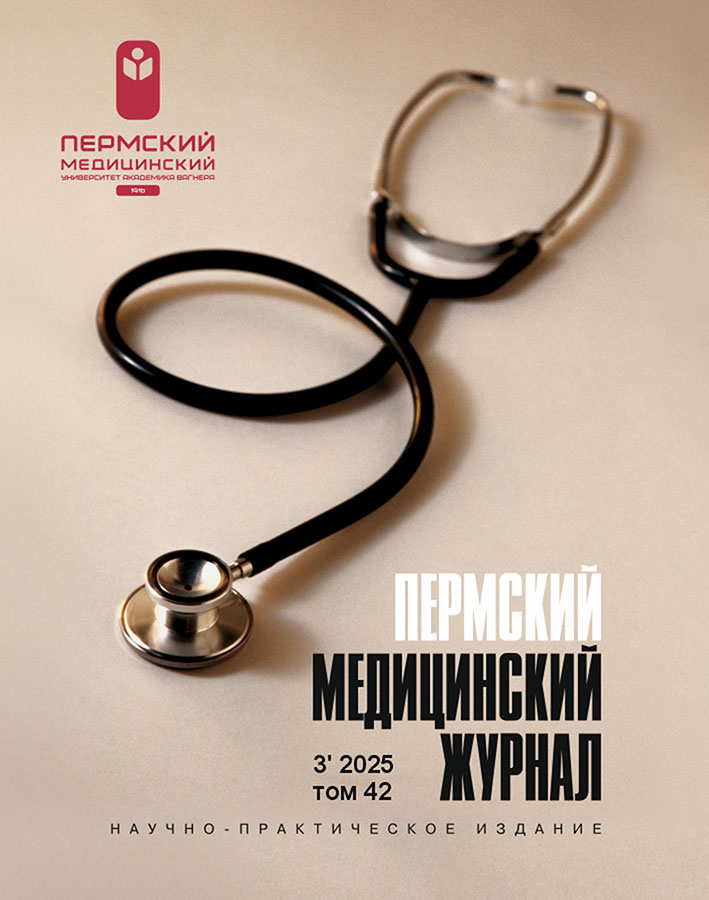Analysis and assessment of morbidity with temporary disability among locomotive crew members in the Perm region in 2019–2024
- Authors: Malyutina N.N.1, Shilkova O.Y.1,2, Sheludko V.S.1
-
Affiliations:
- Ye.A. Vagner Perm State Medical University
- Perm Clinical Hospital «Russian Railways-Medicine Perm»
- Issue: Vol 42, No 3 (2025)
- Pages: 164-171
- Section: Preventive and social medicine
- URL: https://bakhtiniada.ru/PMJ/article/view/312908
- DOI: https://doi.org/10.17816/pmj423164-171
- ID: 312908
Cite item
Full Text
Abstract
Objective. To analyze morbidity among locomotive crew members with temporary disability from 2019 to 2024 in order to determine time series indicators and predicting disease incidence for 2025.
Materials and methods. The disease incidence assessment with temporary disability in the employees of the Perm division of Sverdlovsk Railway service of “JSC Russian Railways” is based on the data of Federal Statistical Observation Form № 19-VN. Statistical processing was carried out on a personal computer using spreadsheet program Excel® 2016 and calculation of time series indicators for the expected values in 2025.
Results. The most frequently occurring diseases of the respiratory, digestive and circulatory systems by the number of total days and incidence assessing morbidity among locomotive crew members were determined.
Conclusions. Respiratory diseases rank first in all indicators. An increase in disease incidence in all groups is observed mostly in 2021 and 2022 which we consider to be associated with coronavirus infection and its complications. For 2025 a rise in the absolute number of cases of respiratory and digestive diseases is expected and an increase in the number of absolute days is projected for respiratory diseases. In 2025, an increase in the incidence rate per 100 employees is projected for respiratory and digestive system diseases. A decrease in the incidence of respiratory diseases by 12,6% (or 8,2‰), digestive diseases by 40,43% (or 1,9‰), and circulatory diseases by 36,54% (or 1,9‰) was determined while analyzing morbidity (per 100 employees) in 2019 – 2024. The rate of increase or decrease in the incidence of all diseases varied unevenly from year to year.
Keywords
Full Text
##article.viewOnOriginalSite##About the authors
N. N. Malyutina
Ye.A. Vagner Perm State Medical University
Email: Dr-malyutina@yandex.ru
ORCID iD: 0000-0002-3475-2505
DSc (Medicine), Professor, Head of the Department of Faculty Therapy №2, Occupational Pathology and Clinical Laboratory Diagnostics
Russian Federation, PermO. Yu. Shilkova
Ye.A. Vagner Perm State Medical University; Perm Clinical Hospital «Russian Railways-Medicine Perm»
Author for correspondence.
Email: Dr.shilkova@gmail.com
ORCID iD: 0009-0004-5422-4277
Postgraduate Student of the Department of Faculty Therapy №2, Occupational Pathology and Clinical Laboratory Diagnostics, Cardiologist
Russian Federation, Perm; PermV. S. Sheludko
Ye.A. Vagner Perm State Medical University
Email: shelvs@rambler.ru
ORCID iD: 0000-0002-7080-9142
PhD (Medicine), Specialist of the Department of Scientific Research
Russian Federation, PermReferences
- Zipes D.P., Wellens H.J.J. Sudden cardiac death. Circulation 1998; 98: 2334–2351.
- World Health Organization. A global health strategy for 2025–2028-advancing equity and resilience in a turbulent world: fourteenth General Programme of Work. Geneva: World Health Organization 2025.
- Malyutina N., Luzina S., Shilcova O. P-151 the risk prediction of comorbid pathology development of locomotive drivers with arterial hypertension. Occupational Medicine 2024; 74 (1). doi: 10.1093/occmed/kqae023.0668
- Бухтияров И.В., Кузьмина Л.П., Измерова Н.И., Головкова Н.П., Непершина О.П. Совершенствование механизмов выявления ранних признаков нарушения здоровья для сохранения трудового долголетия. Мед. труда и пром. экол. 2022; 62 (6): 377–387. doi: 10.31089/1026-9428-2022-62-6-377-387 / Bukhriayrov I.V., Kuzmina L.P., Izmerova N.I., Golovkova N.P., Nepershina O.P. Improvement of mechanisms of detecting early signs of health disorders for preservation labour longevity. Med. truda i prom. ekol. 2022; 62 (6): 377–387. doi: 10.31089/1026-9428-2022-62-6-377-387 (in Russian).
- Вильк М.Ф., Цфасман А.З. Медицинское обеспечение безопасности движения поездов. М.: Московский центр непрерывного математического образования 2002; 296. / Vilk M.F., Tsfasman A.Z. Medical provision of train traffic safety. Moscow: Moscow Center for Continuing Mathematical Education 2002; 296 (in Russian).
- Жидкова Е.А. и др. Анализ факторов, ассоциированных с заболеваемостью работников локомотивных бригад. Кардиоваскулярная терапия и профилактика 2019; 18 (1): 102–106. / Zhidkova E.A. et al. Analysis of factors associated with the morbidity of locomotive crew workers. Cardiovascular Therapy and Prevention 2019; 18 (1): 102–106 (in Russian).
- Лучкевич В.С., Самодова И.Л. Относительные величины: учебно-методическое пособие. Под ред. В.С. Лучкевича. СПб.: Изд-во СЗГМУ им. И. И. Мечникова 2014: 56. / Luchkevich V.S., Samodova I.L. Relative values: an educational and methodical manual. Edited by V.S. Luchkevich. Saint Petersburg: Publishing house of NWSMU named after I.I. Mechnikov 2014: 56 (in Russian).
- Малютина Н.Н., Шевчук В.В., Шилкова О.Ю. Факторы риска и прогнозирование вне¬запной сердечной смерти (обзор литературы). Анализ риска здоровью 2023; 2: 297–304. /
- Malyutina N.N., Shevchuk V.V., Shilkova O.Yu. Risk factors and prediction of sudden cardiac death (literature review). Health Risk Analysis 2023; 2: 297–304 (in Russian).
- Цфасман А.З. Профессиональная кардиология 2007; 9–45. / Tsfasman A.Z. Professional cardiology 2007; 9–45 (in Russian).
- Шелудько В.С., Девяткова Г.И. Теоретические основы медицинской статистики (статистические методы обработки и анализа материалов научно-исследовательских работ): метод. рекомендации. Пермь: ПГМУ им. акад. Е.А. Вагнера 2016. / Sheludko V.S., Devyatkova G.I. Theoretical foundations of medical statistics (statistical methods of processing and analyzing research materials): method. recommendations. Perm: Perm State Medical University named after Ye.A. Vagner 2016 (in Russian).
Supplementary files









